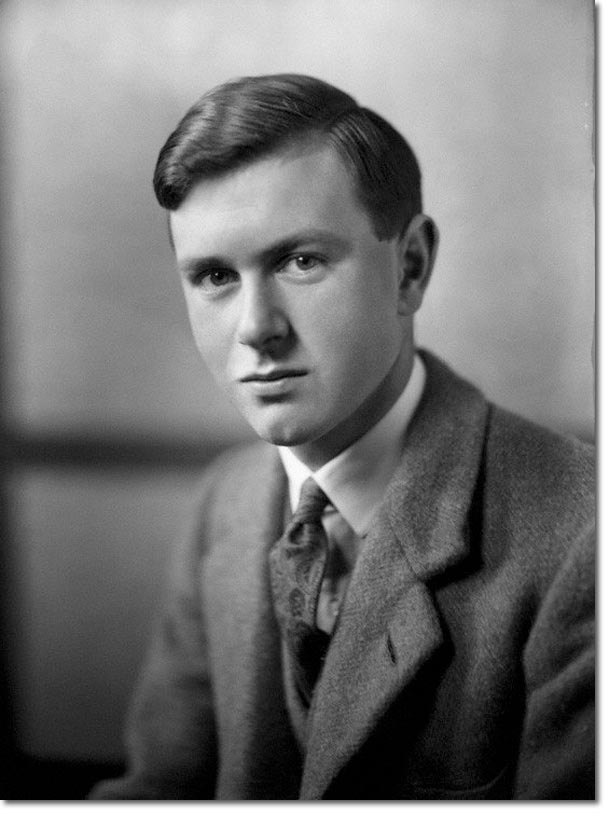|
|

 |
|
Miles Francis Stapleton Fitzalan-Howard was born on 21 July 1915, the eldest son of the 3rd Baron of Howard of Glossop, and Baroness Beaumont, a peeress in her own right. Miles inherited these titles in 1971/2 but throughout his military career he was the Hon Miles Fitzalan-Howard. He became the Duke of Norfolk and Earl Marshal in 1975. He was one of 8 children brought up at Carlton Towers, Yorkshire and educated at the Roman Catholic school, Ampleforth. He went up to Oxford and gained a third in History at Christ Church. The photo shows him in 1936 as an undergraduate. He entered the Grenadier Guards on 27 Aug 1937 and was promoted to lieutenant on 30 Jan 1939. He and his brother went off to war having received the sign of the cross on their foreheads from their mother.
He at first commanded an anti-tank platoon in the BEF and took part in the defence of Louvain. At Dunkirk there was an impressive battalion parade on the beaches while under fire. This impressed Montgomery so much that many of the officers were sent to Staff College. Later when Miles was DAQMG of the Guards Armoured Division on their way by rail to Scotland he requisitioned Doncaster's station restaurant to feed the men who would otherwise have gone hungry. He sent the bill to the War Office. In 1943 he was in an expedition to secure Tangier and went on to fight in North Africa. From there Miles was sent to Sicily and Southern Italy where the troops nicknamed him Bloody Kilometers. He won the MC at the battle of the river Sangro in April 1944 for carrying out recces on foot and under fire when the tanks were held up by mines. On D-Day he took part in the landings as brigade major of 5th Armoured Brigade. He met his wife, Anne Constable-Maxwell when he was military attache in Washington. They married in 1949. In the Suez Crisis he was in command of the 2nd Battalion but in 1957 left that post to be head of the British Military Mission to the Russian Forces in Germany. He took advantage of his position to cross the Iron Curtain to steal parts of Soviet equipment and take photos. But he was apprehended several times because he was being 'grassed up' by the MI6 traitor George Blake. From 1961 to 63 he was in command of 70 Brigade (King's African Rifles and Kenya Regiment), learning Swahili and creating more than 100 African officers. He was GOC the 1st Division from 1963 to 65. His final job with the military was in 1966 as director of Service Intelligence at the Ministry of Defence but he resigned having become disillusioned with Whitehall red tape. On retiring with the rank of major-general from the army he worked in banking and took his seat in the House of Lords as Duke of Norfolk as well as carrying out the duties of Earl Marshal and head of the College of Arms. He immediately overturned plans to hand over the family's Arundel Castle to the National Trust, forming an independent charitable trust to maintain it. He was a keen historian and organised a memorable celebration of 500 years of the dukedom in 1983 in which there was an ecumenical service at the Tower of London to bring Archbishop Hume together with the Archbishop of Canterbury. The libraries and family archives were catalogued and refurbished by scholars employed by him. Also in 1983 he became a Knight of the Garter. But he was a humorous and blunt-speaking man who on one occasion introduced a very correct dowager to astonished guests, "You all know this old tartar, I'm sure." He was happier with informality, and preferred manual work and gardening to socialising. He was a devout Catholic and always instructed tailors who made his suits and uniforms to make an inside pocket big enough for a missal. He attended the funerals of two Popes and the enthronement of John Paul II in 1978, who decorated him with the Order of Pius IX. He died on 24 June 2002 leaving two sons and three daughters. He is buried at Arundel Castle. |
Regimental details | Commanding Officers
Armed Forces | Art and Culture | Articles | Biographies | Colonies | Discussion | Glossary | Home | Library | Links | Map Room | Sources and Media | Science and Technology | Search | Student Zone | Timelines | TV & Film | Wargames